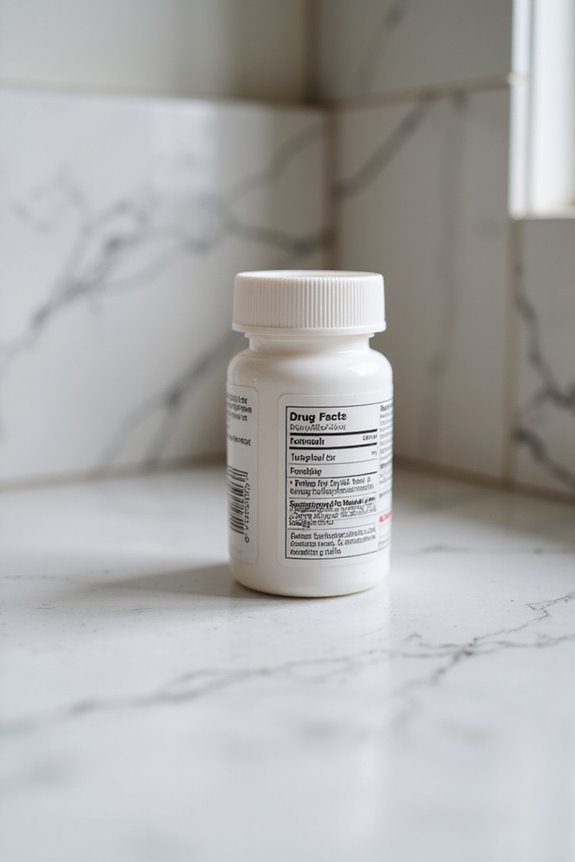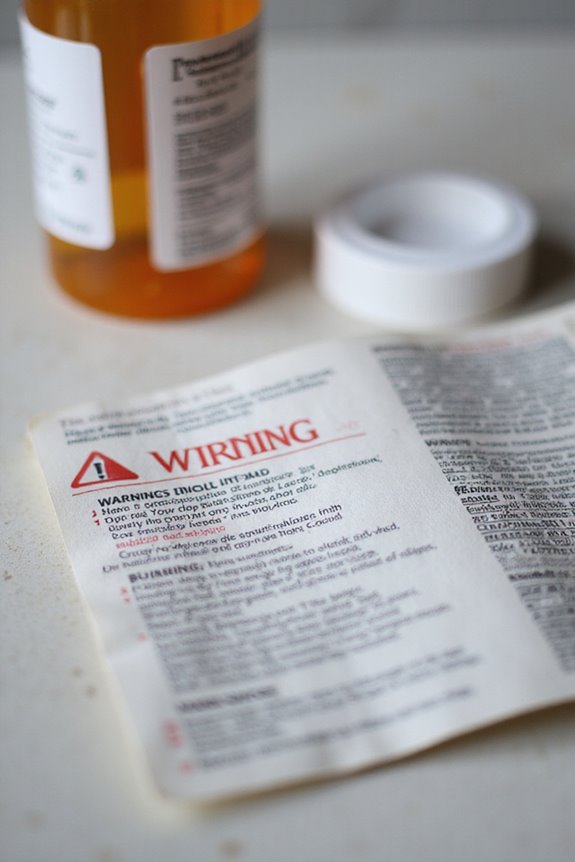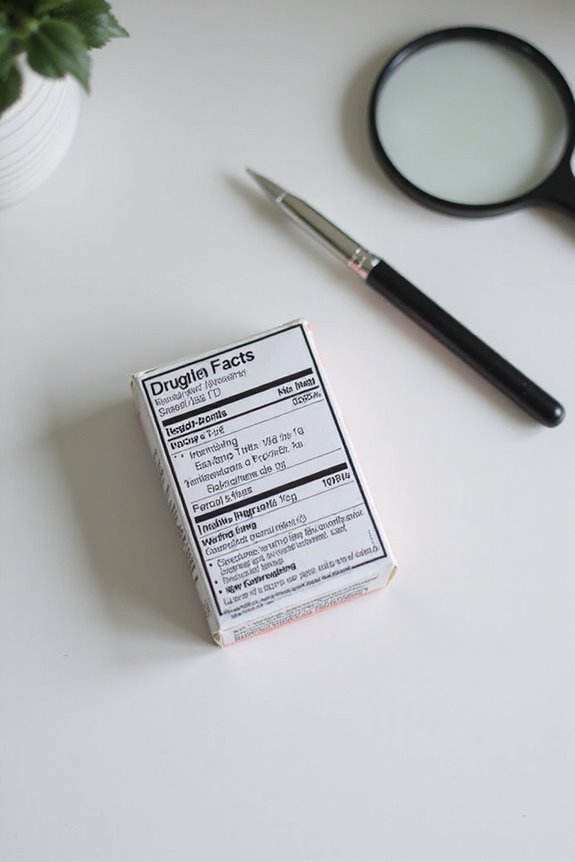To read an OTC drug facts label effectively, observe these key sections:
- Active Ingredients: Identify therapeutic components and their amounts.
- Purpose and Uses: Understand the drug class and targeted symptoms.
- Warnings: Note any contraindications or health concerns.
- Directions for Use and Dosage: Follow age-specific dosage instructions for safety.
- Inactive Ingredients: Be aware of potential allergens and inactive components.
Exploring these aspects enhances safety and efficacy. Additional information is available for a more thorough understanding.
Key Takeaways
- Start with the active ingredients section to identify the therapeutic components and their dosages.
- Check the purpose and uses to understand the drug class and targeted symptoms treated.
- Read the warnings to learn about contraindications and safety precautions specific to your health conditions.
- Follow the directions for use carefully, noting age-specific dosages and maximum daily limits.
- Review inactive ingredients for potential allergens and to understand the formulation better.
Understanding Active Ingredients
Active ingredients are the core components of over-the-counter (OTC) medications that provide therapeutic effects. Their significance lies in their ability to deliver specific pharmacological activities, making them crucial for effective treatment.
- The active ingredient section appears at the beginning of the OTC drug facts label, listing all pharmacologically active components.
- It specifies the amount per dosage unit, ensuring clarity and safety.
- Common ingredient examples include acetaminophen, ibuprofen, and diphenhydramine, each serving distinct purposes.
Understanding these active ingredients is essential for informed decision-making, enabling consumers to avoid accidental duplication of medicines. Recognizing the active ingredient significance enhances safety, particularly for individuals with allergies or medication sensitivities. Always read labels thoroughly to empower personal health choices.
Identifying Purpose and Uses

Understanding the purpose and intended uses of OTC medications is critical for consumers seeking effective symptom relief.
Identifying Symptoms
The purpose section of the label defines the drug class, such as antihistamines or analgesics, and summarizes the symptoms targeted. This clarity helps consumers match their specific needs with the medication’s intended function.
Understanding Mechanisms
The uses section lists conditions treated, such as headaches or runny noses, guiding appropriate selection. This prevents misuse by ensuring medications are used only for specified symptoms.
Informed Decision-Making
Clear labeling promotes safer self-care, facilitating informed choices. Consumers can avoid unnecessary medications and seek professional advice when symptoms persist, ensuring that they use OTC products effectively and safely.
Recognizing Warnings

Recognizing warnings on an OTC drug facts label is essential for safe and effective medication use. These warnings provide critical safety precautions and contraindications awareness to help consumers make informed decisions.
Do Not Use Warnings:
– Explicitly state situations prohibiting product use, including allergies and certain medical conditions.
Ask a Doctor Before Use If You Have:
– Chronic health issues like heart disease, high blood pressure, or diabetes.
Pregnancy and Breastfeeding:
– Seek medical guidance before use to mitigate risks to the mother and child.
Storage and Tampering:
– Check for tamper-evident packaging and adhere to storage instructions.
Understanding these warnings guarantees that consumers protect their health and avoid adverse effects while using OTC medications.
Following Directions for Use and Dosage

Following directions for use and dosage is essential for the safety and efficacy of over-the-counter (OTC) medications. Adhering to dosage instructions guarantees that individuals take the correct amount of medicine per dose and follow frequency guidelines, such as administering doses every 4 to 6 hours.
- Dosage varies by age groups; adults, children, and infants may require different amounts.
- Labels often specify maximum daily doses to prevent overdose.
- Some formulations are tailored specifically for children and may be based on body weight.
- Incorrect use can lead to serious side effects or inadequate treatment.
Consulting a healthcare provider or pharmacist is recommended when administering OTC medications to children or when there is uncertainty regarding usage.
Reviewing Inactive Ingredients and Other Information

Reviewing inactive ingredients is an essential step in understanding the complete profile of over-the-counter (OTC) medications. These ingredients, listed alphabetically, serve important roles such as preservatives, fillers, and flavoring agents, guaranteeing product stability and palatability.
Key points regarding inactive ingredients include:
- Consumer Safety: Awareness of inactive ingredients is significant, as they can cause allergic reactions or sensitivities.
- Transparency: Products may indicate variability with an asterisk, helping consumers identify potential allergens.
- Healthcare Guidance: Complete ingredient disclosure aids pharmacists and healthcare providers in advising patients effectively.
Understanding the inactive ingredient section enhances consumer safety, guarantees informed choices, and promotes awareness of potential interactions with other medications or conditions. This knowledge fosters a sense of belonging and responsibility in personal health management.
Frequently Asked Questions
How Can I Tell if a Drug Is Expired?
When evaluating expired medication signs, one must check expiration dates printed on packaging. If faded or unclear, contacting the manufacturer can provide clarity, ensuring safety and efficacy, fostering a sense of community health awareness.
What Should I Do if I Miss a Dose?
When a missed dosage occurs, individuals should assess medication timing; typically, taking the missed dose promptly is advised if remembered soon. If nearing the next dose, it’s best to skip and continue the schedule.
Can I Take Multiple OTC Medications Together?
When considering multiple OTC medications, one must recognize potential drug interactions. Adhering to dosage guidelines is essential, as overlapping ingredients can lead to unintentional overdosing, emphasizing the importance of consulting a healthcare professional for safety.
Where Can I Find Customer Reviews for OTC Drugs?
In the quest for reliable customer reviews for OTC drugs, individuals often turn to customer review platforms, online pharmacy ratings, and forums. These resources foster community sharing, enabling informed decisions based on others’ experiences and insights.
How Do I Report an Adverse Reaction to an OTC Drug?
To report an adverse reaction for OTC drugs, individuals should submit details electronically to the FDA, ensuring adherence to guidelines for OTC drug safety. This collective effort enhances consumer protection and promotes informed health choices within communities.


